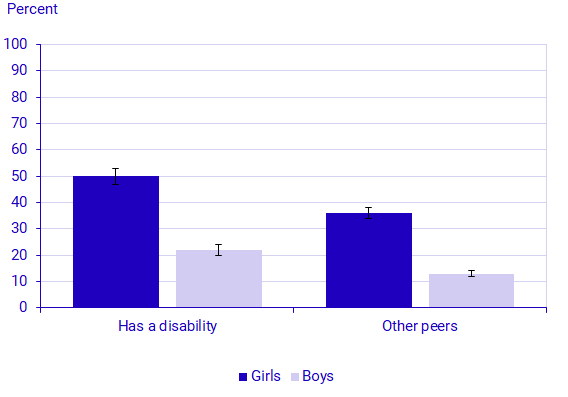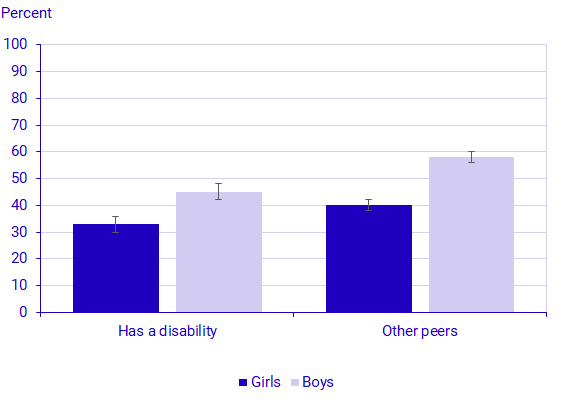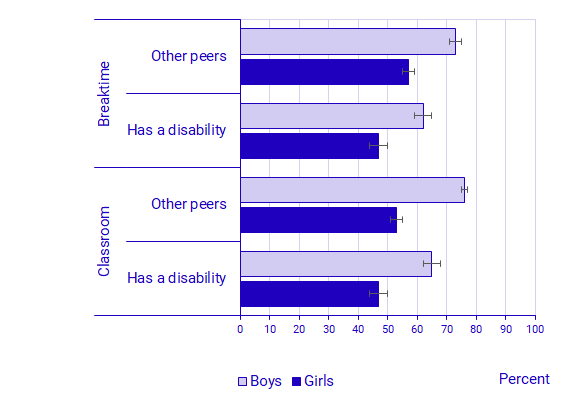Children and their families 2023
Young people with disabilities feel down more often than their peers
Statistical news from Statistics Sweden 2024-11-27 8.00
A new report from Statistics Sweden (SCB) reveals that the living conditions of children with disabilities differ from those of other children of the same age, both at school and during their free time.
The report examines children's experiences in various areas, including school, free-time activities, relationships with parents, teachers, and peers, their involvement in household tasks, financial situations, and feelings of safety. The data is based on the 2023 survey on children's living conditions (Barn-ULF).
– “Although it is encouraging to see that most children in Sweden are doing well, it is clear that children with disabilities face greater challenges” says Dr. Koutakis, who, together with colleagues at SCB, compiled the report.
“While it is encouraging to see that most children in Sweden are doing well, it is clear that children with disabilities face greater challenges,” says Nikolaus Koutakis, who collaborated with colleagues at Statistics Sweden (SCB) to compile the report.
Children with Disabilities Have Lower Well-Being
The report reveals that a smaller proportion of children with disabilities feel well or are satisfied with themselves compared to other children. A larger share of these children report sleep problems and fatigue at school.
Half of all girls with disabilities often or mostly feel sad or low, compared to 36% of other girls. Among boys with disabilities, 22% feel the same, while the corresponding share for other boys is 13%.

Children with Disabilities Face Challenges in School
Compared to other children, a smaller proportion of children with disabilities experience a satisfying work environment or have close friends in their class, and a higher proportion report being subjected to bad treatment by both teachers and peers at school. A higher proportion of girls with disabilities feel they do not receive the same support from teachers as other girls. For boys, the differences are not statistically significant.
Among boys with disabilities, 45% say they are very happy in their class, compared to 58% of other boys their age. Similarly, a smaller proportion of girls with disabilities are very happy in their class compared to other girls their age. The difference between the two groups is 7 percentage points—33% compared to 40%.

Lower Proportion of Children with Disabilities Feel Safe
Children with disabilities do not feel as safe in their neighborhoods, on their way to and from school, or at school compared to their peers.
Among boys with disabilities, 65% feel very safe in the classroom, which is lower than the 76% of other boys their age. The smallest share is found among girls with disabilities, with only 47% feeling very safe in the classroom, compared to 53% of other girls their age.
A similar pattern and nearly identical proportions are reflected in children’s responses regarding safety during breaktime in school.

Children with Disabilities Spend More Time on Screen-Based Activities During Leisure
A larger proportion of children with disabilities, especially girls, engage in screen-based activities during their free time. This includes all online activities such as gaming, studying, chatting, and watching movies on mobile devices, tablets, computers, or TVs.
Children with disabilities read books and participate in sports less frequently than their peers.
Gaming is about twice as common among boys than among girls. Among boys with disabilities, 43% play video games, compared to 33% of other boys. For girls with disabilities, 18% play video games, compared to 13% of their peers without disabilities.

Definitions and explanations
The following question was used to identify the group of children with disabilities:
"Do you have a long-term illness, disability, or other long-term health problem (such as diabetes, allergies, eczema, or ADHD) that has been diagnosed by a doctor?"
With this concept, 26 percent of children aged 12–18 have a disability, which corresponds to approximately 868,000 children, with an equal number of girls and boys.
Publication
Children and their families
Feel free to use the facts from this statistical news but remember to state Source: Statistics Sweden.
